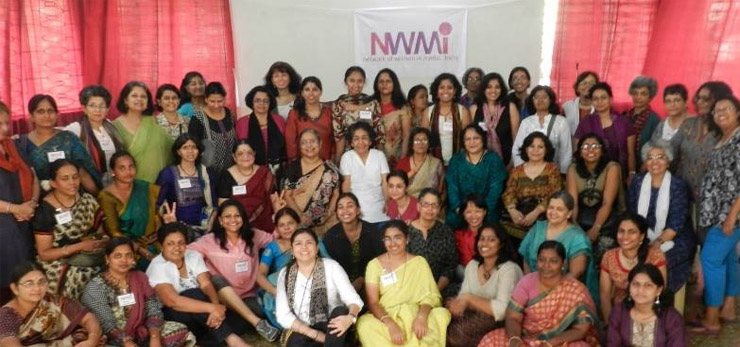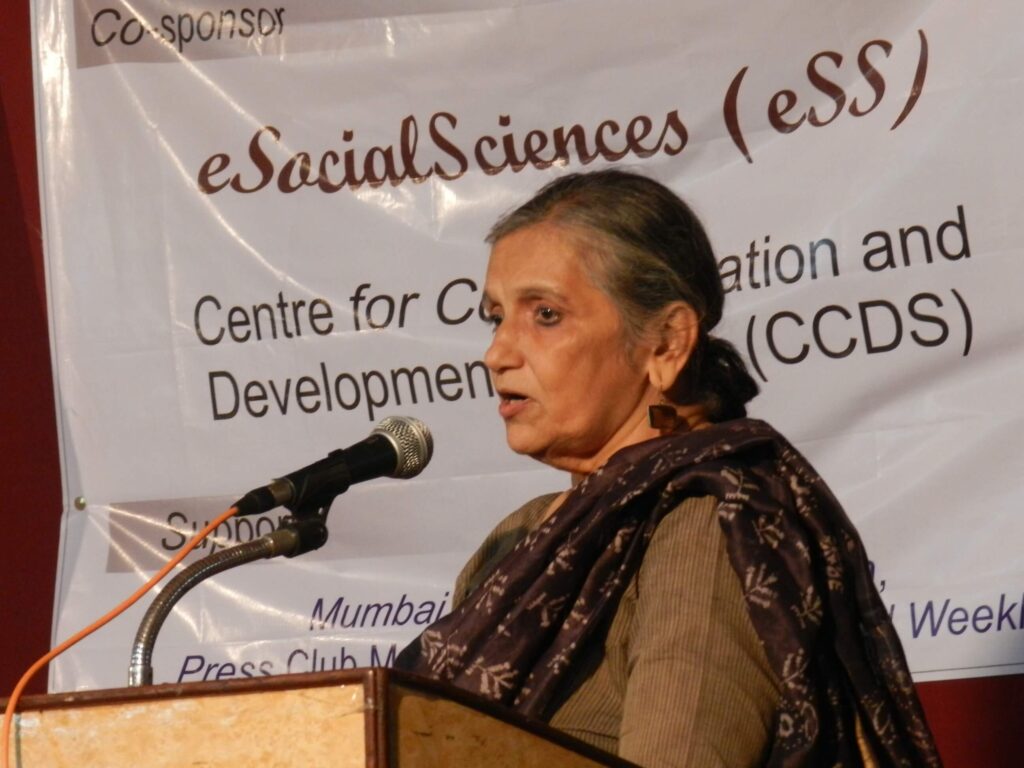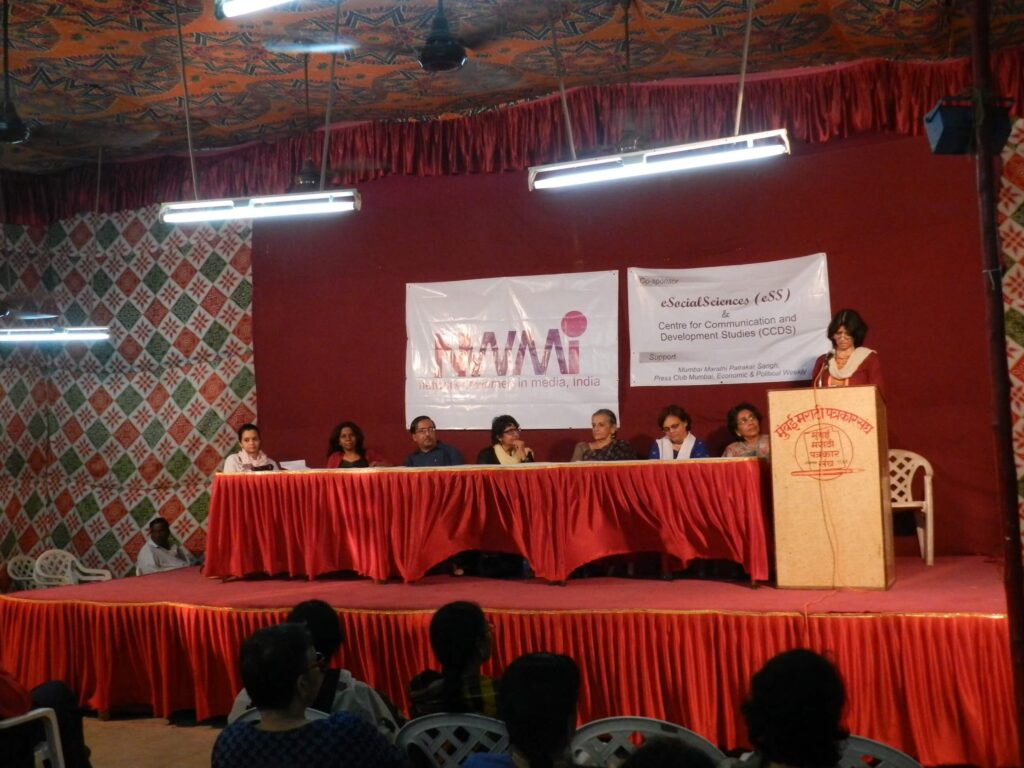The recent brutal gang rape-murder of a woman in Delhi and the thunderous public outrage it raised around the country has centre-staged the issue of violence against women. But millions of words and sound-bytes later, has there been sufficient depth of thought to the relevant issues? Can Justice Verma’s pathbreaking report put pressure on the government and will this pressure deal with the crucial concerns? How can the media play a positive role? It was with these introductory questions that senior journalist and columnist Kalpana Sharma called upon a variety of speakers to address the audience at the Mumbai Marathi Patrakar Sangh, where some 80 women journalists had gathered for NWMI’s 10th anniversary national convention. This public event on “Women, violence and the public space: how the media can tell that story better” was coincidently held on the day that the government announced its ordinance in reply to the Justice Verma commission.
Women, violence and the public space: how the media can tell that story better

Public session: Women, violence and the public space: how the media can tell that story better
February 2, 2013
The media is a multi-edged sword. While it draws attention to the pertinent issues, sometimes excessive coverage and intrusive reportage – such as in the case of sexual assault and rape – causes an aversion and an unnecessary fear in the minds of readers and viewers, often resulting in greater curbs on the movement of women in public spaces. These issues were discussed at NWMI’s 10th anniversary meet in Mumbai. A report on the session:
Details
Session Reports
From voyeuristic behaviour to a constructive role
Lawyer-activist Flavia Agnes recalled the 1980s when women first raised demands for legal amendments to prevent sexual violence. She acknowledged she was a product of the media, who had profiled her and enabled her work as a lawyer and activist to reach the public space even as she attempted to keep pushing the boundaries of women’s rights in the legal domain. However, she decried the current “insatiable greed of voyeurism” which sought out the most gruesome and private details of a rape survivor. She also pointed to the hypocrisy of revealing every single detail about the survivor except her name by the media. The relentless intrusion and desperate need to “put a face” and find “real victims” had driven a survivor to say, “For us the greatest horror was the media.” A raped woman has no name and no face, she said with characteristic bluntness.

Agnes wondered whether one had moved an inch towards a better understanding of what it meant to be a survivor, even after printing or portraying such details. In this connection she pointed out how her organisation Majlis sought to counteract the “zinda laash” rhetoric by ferreting out and re-publishing the account of a raped woman who had written about her rape and her struggle to come out of the fear and violence. She appealed to the media to play a constructive role by dropping the gory details, by not placing the lifelong label of a victim on the survivor, and by being supportive to a process of surviving, coping and healing.
The limitations of the newroom
Meenal Baghel, editor, Mumbai Mirror, candidly admitted the lapses of her paper in the past, pointing out that newsrooms had their limitations and imperfections. The pressure in a newsroom was akin to that felt by doctors working in emergency wards, she said. In the working process one did sometimes get de-sensitised but by and large the process of questioning the treatment of this issue has begun in media circles. She pointed out that Mumbai Mirror had never used the euphemism “eve teasing,” and this was the outcome of a conscious decision. While much reporting happens in an ad hoc, templatised manner, with no hard and fast rules, the newsroom is definitely more discerning and sensitive today than it was in the past. Baghel recommended that NWMI continue with its gender-sensitivity workshops for journalists.
Nandita Gandhi, co director of the organisation Akshara, a woman’s resource centre, pointed out that in the 1980s when women took to the streets in the wake of the Mathura rape case, the media had covered the protests out of curiosity. Now there was a quantum leap in reporting but she too felt that in the recent media coverage there was too much description and the sensationalism bordered on what she described as “redlight area journalism” and a misogynistic curiosity. She pointed out the gross insensitivity of the media in placing inappropriate advertisements within news items regarding violence, and the absence of an objective and firm stand in publishing, at random, views that do nothing to support the cause. “Let us admit that the emperor has no clothes on,” she said. She urged the practice of ethics and went on to elaborate on the tie-up her organisation had undertaken with the newspaperHindustan Times (HT): Akshara carried out an extensive survey on issues of sexual harassment and safety of women in public spaces, and HT wrote and carried out a 15-day campaign on the survey findings. This highlighted the catalytic role that media organisations can play. She also pointed out that in such collaborations, it becomes a win-win situation: the women’s organisation is able to harness the resources of the media house, and the media house receives socially relevant content.
The media must take a historical perspective
Speaking on the fabled safety of women living in Mumbai, Lina Mathias, senior assistant editor at Economic & Political Weekly, drove home the fact that the safety of women does not exist in a vacuum; it is connected with the city’s political and social consciousness. If Mumbai was seen as a safe city it was because white-collar workers and blue-collar workers had fought for their rights and collectively created a culture of public action and the demand for accountability. Trade unions like the Philips employees union took pains to distribute copies of the Vishakha judgement guidelines on sexual harassment to all women at the workplace. She narrated the endearing case of one Narayanrao Lokhande, a mill worker, who as early as 1890 convened a meeting of barbers and made them take an oath that they would not shave the heads of widows!

But now the city was losing such political and social consciousness and collective action is conspicuous by its absence. Hawkers, whose presence on the streets has been proved reassuring for women in several locations besides Mumbai, are being ruthlessly evicted. BEST, the public transport system, has curtailed its services, and there is not a whimper of protest. Days of megablocks in the Central Railways, without proper alternative arrangements, causing the deaths of three youths falling off overcrowded trains, but there has been no dharna, no morcha against the Railways’ callousness. How can women expect to remain safe in an environment such as this, she asked. And when people are being hounded out to relocate in far-off suburbs, commuting as many as six hours a day, who has the time and the energy to protest? She urged the media to take a historical perspective and connect the dots when talking about not only women’s but the common people’s safety.
Harish Sadani of Men against Violence and Abuse noted that it was important for those engaged with the issues of gender violence to also initiate discussions on positive models of masculinity. He said the media must encourage processes that humanise men, and create spaces where they are seen not as perpetrators but as part of the solution. He drew attention to instances in the city where male bystanders had even died while intervening and defending women who were being sexually harassed. However, the media paid scant attention to such stories. He also spoke about his work on sensitisation of youth in Pune, Kolhapur, Satara and elsewhere, in which young boys are presented positive, egalitarian models of masculinity. However, here too, the media ignored such stories. Again, when the proposal to impart sex education was shot down due to political pressure, no media organisation came forward to do follow up stories. Sadani said that if violence against women is projected as social violence, it should include men in the picture and place on them the responsibility of being part of the solution rather than the problem. Unless men are seen as part of the solution, how will the gender problem be resolved?
The spaces offered by the new media
Anindita Sengupta, a feminist blogger (http://ultraviolet.in/), wound up the session by explaining how new media has given spaces and opportunities to create content that is not compromised. She gave her own example of how she fought her own case of sexual harassment by getting information online and then starting Ultraviolet, a group blog of Indian women who face violence or discrimination. The collaborative mode, meant largely for those under 40, has accommodated a variety of topics from the sharing of household chores to domestic violence. She pointed out that websites and blogs were easy to create, cheap, and more focused on target groups. Also, there is freedom to choose the content and its length, which makes the gamut of new media, with possibilities of cross-publishing, an attractive option. She called on women to attempt working with both traditional media and the new media, so as to be in the best of both worlds.
Rapporteurs for the session: Shubha Khandekar, Freny Manecksha


